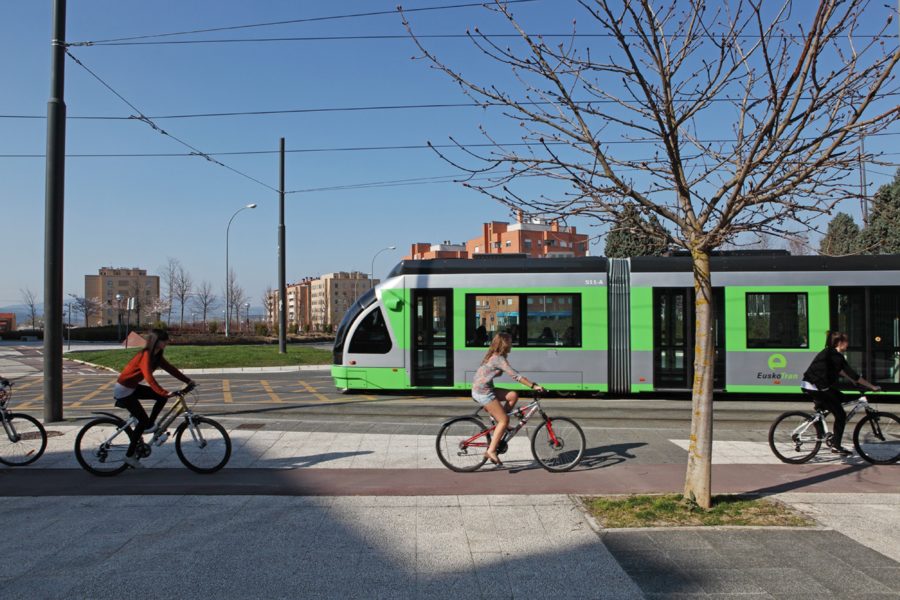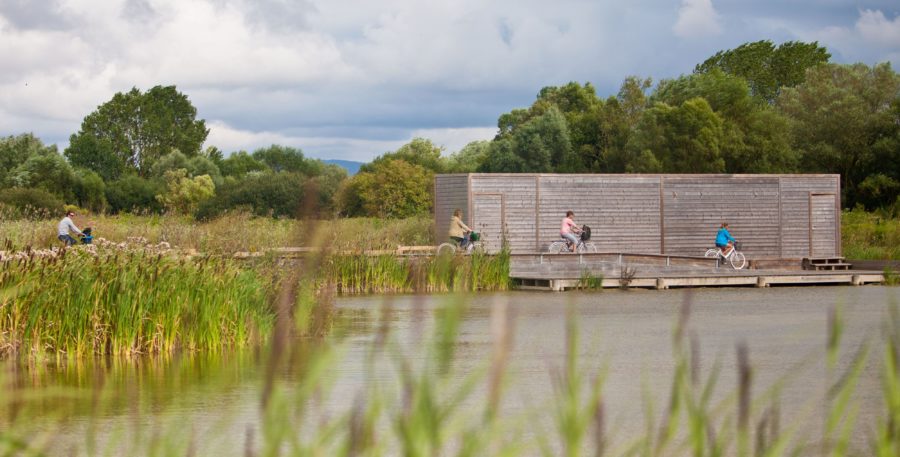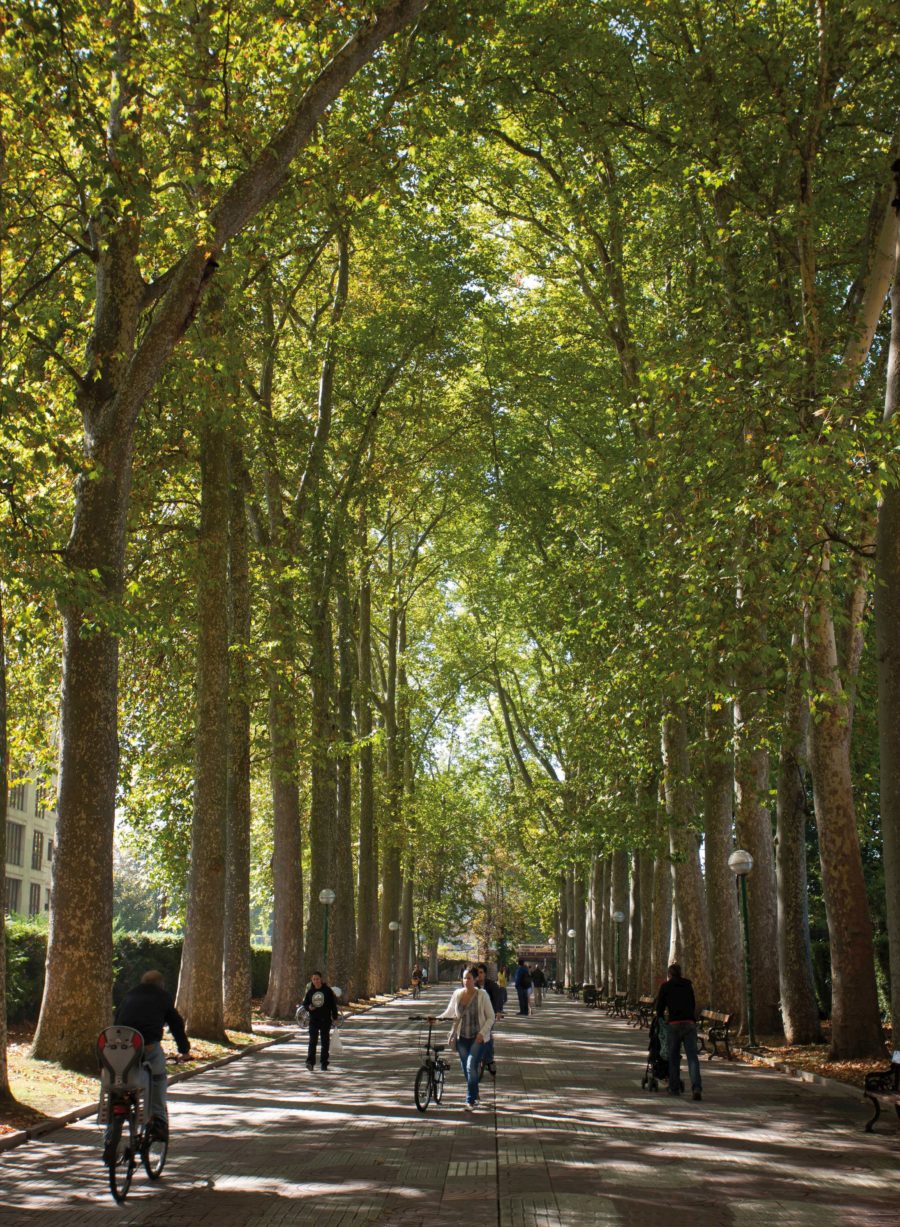
Interview with Mr. Gorka Urtaran , Mayor of Vitoria-Gasteiz
Check out the interview with Mayor of Vitoria-Gasteiz, posted in the IAEC Bulletin 33!
You’re proud to have been born and bred in Vitoria. What are the characteristic features of this city?
It’s a very special city. A city which, thanks to its size, is also one big community that you feel part of. Not everyone knows each other, of course, but there’s definitely a very strong feeling of identity and belonging. I grew up here, I made my life here and now I’m proud to be the mayor.

It’s a city with countless possibilities to enjoy nature both inside and outside the urban limits.
A comfortable, accessible, medium-sized city where it’s easy to get around on foot, by bike or by public transport. What’s more, it’s a benchmark city in environmental matters, having been named European Green Capital 2012 and Global Green City 2019.
A city of services, which is also something that’s highly valued, with a wide and affordable range of quality public services, with civic centres being the flagship.
It’s also a city with a huge historical heritage. The best example is the medieval town and the many palaces and old buildings that we have.
And I can’t forget our industry, which supports the city’s economy and also gives it character, leaving an important imprint on our identity and on the history of many of our neighbourhoods, which appeared thanks to industry and grew thanks to industry.
From your double perspective as a mayor and as a sociologist, what are the main challenges facing your city? What are the lines of action involved?
To a large extent, they’re challenges shared with the whole planet, always with their own characteristics, because our city has some features that make it special. Possibly the biggest challenge that we’re facing as a city and as a planet is the climate crisis and everything that this implies in terms of changing our way of life. But there are also other challenges such as social cohesion and an ageing population.
We’re experiencing changes in the production model and major adaptations in industry, especially in the automotive sector, which is a cornerstone of our industry. As a result, the city council is working closely with local companies to streamline their adaptation strategies with the tools such as urban planning or the improvement of industrial estates. What’s more, we’re creating an innovation ecosystem with a project known as the Mobility Lab. In short, being allies with our companies to continue providing quality jobs in our city.
Another challenge is the energy model, which affects transport, households and the manufacturing industry. In this sense, we need to make a key change in order to improve energy efficiency, use renewable sources and create carbon sinks to achieve carbon neutrality, which is key to offsetting the effects of climate change. As a city council, we’re launching some major projects, such as the SmartEnCity in Coronación, which improves the energy efficiency of homes in this historic neighbourhood of the city, and also the promotion of energy communities or the replacement of public lighting with LEDs. That said, the number one project is taking part in the European Commission’s objective of 100 climate-neutral cities by 2030, which is an ambitious and exciting project that can help us respond much faster to all these changes.
 The transformation of urban mobility, like in other cities, is undergoing major changes aimed at reducing CO2 emissions, electrification, enhancing active mobility, or fostering decarbonised and high-capacity public transport. For this, in Vitoria-Gasteiz we’re improving our bike lane infrastructure, which already stretches more than 170 kilometres. What’s more, we’re continuing to enhance and expand pedestrian areas and focus on high-capacity electric public transport such as trams, with the line to the university that was opened in 2020, or the Salburua line currently under construction and which will be in operation in the spring of 2022. And we’re also implementing smart eBuses that cover the peripheral line with a faster, safer and sustainable system.
The transformation of urban mobility, like in other cities, is undergoing major changes aimed at reducing CO2 emissions, electrification, enhancing active mobility, or fostering decarbonised and high-capacity public transport. For this, in Vitoria-Gasteiz we’re improving our bike lane infrastructure, which already stretches more than 170 kilometres. What’s more, we’re continuing to enhance and expand pedestrian areas and focus on high-capacity electric public transport such as trams, with the line to the university that was opened in 2020, or the Salburua line currently under construction and which will be in operation in the spring of 2022. And we’re also implementing smart eBuses that cover the peripheral line with a faster, safer and sustainable system.
Another major challenge is social cohesion. Vitoria is a cohesive city, but we must strive to maintain and improve this. We’re working on values such as harmonious living, equality, diversity and human rights. The quality of life is high here and the level of public services is good, while our economic model is robust. This helps the city move forward in a balanced fashion, leaving no one behind. If there’s one thing that defines society in Vitoria and the Basque Country as a whole, it’s the cohesion found here, which with its shortcomings is one of the most egalitarian and cohesive societies in Spain. This is one of our main assets. If we leave out a part of society, we’ll struggle to move forward.
And last, but not least, an ageing population. Our society, in Vitoria and in much of Europe, is experiencing an ageing process with lower birth rates and higher life expectancy. This has important implications for our health system, but also for the other public services that we provide or even for the configuration of public spaces. I still don’t think that we’re able to envisage the effects of this ageing process in the medium term. We need to engage in serious reflection on this because it’s a far-reaching phenomenon.
In 2012, Vitoria-Gasteiz was named European Green Capital and in 2019 Global Green City. What aspects and initiatives helped the city win these awards?
In both cases, we should talk about a joint effort. Institutions and citizens are key to achieving a city like ours. But it’s not the job of a single mayor or a single government team. The great virtue of these achievements lies in the ongoing commitment to sustainability that all mayors have had since the time of José Angel Cuerda, who was the first to attach importance to sustainability. All of us have contributed improvements and projects that have created and established the city’s sustainable identity. What’s more, another key issue is that the city itself has internalised this identity and made it its own, which paves the way for progress.
 It’s difficult to label one project as vital for achieving these goals. Maybe the green belt is the most significant project, but I think that it’s all our initiatives, the green infrastructures, our water management system, our extensive network of bike paths, our urban mobility policies, our projects to improve public spaces, and so on. There are lots of projects but it’s all of them as a whole that makes us special.
It’s difficult to label one project as vital for achieving these goals. Maybe the green belt is the most significant project, but I think that it’s all our initiatives, the green infrastructures, our water management system, our extensive network of bike paths, our urban mobility policies, our projects to improve public spaces, and so on. There are lots of projects but it’s all of them as a whole that makes us special.
Vitoria-Gasteiz has seen major changes in urban mobility in recent years. For example, the Citizen Pact for Sustainable Mobility has resulted in the car losing its dominance in favour of pedestrians and bicycles. How was this change in behaviour achieved? In your view, to what extent do sustainability and education go hand in hand?
They’re gradual changes. We’ve been using a four-yearly survey to measure mobility in the city for more than a decade now, and in each new study we’ve seen how this change has come about. As I mentioned, citizen engagement helps, because they’re the people who ultimately decide to use the bus, the cycle path or the pavement to get around and leave their cars at home.
F or our part, the city council has to provide the resources and, sometimes, make bold decisions that lead to major changes. We should also make it easier for all this to happen, such extending and improving bike lanes (with more than 170 kilometres in the city now), increasing pedestrian areas with revitalisation projects such as the area around the Memorial, creating so-called super blocks, improving public transport, extending the tram network or implementing a new smart eBus system.
or our part, the city council has to provide the resources and, sometimes, make bold decisions that lead to major changes. We should also make it easier for all this to happen, such extending and improving bike lanes (with more than 170 kilometres in the city now), increasing pedestrian areas with revitalisation projects such as the area around the Memorial, creating so-called super blocks, improving public transport, extending the tram network or implementing a new smart eBus system.
In short, we need to keep up with these changes. Fortunately, our city has historically been able to address these changes based on social consensus. Citizens are able to value these decisions, because they know the positive side of a city on a human scale.
Can you explain what the Vitoria-Gasteiz Green Deal consists of and how it will influence the city’s future?
The aim is to foster consensus among social, economic and environmental stakeholders in order to develop groundbreaking initiatives that respond to the climate crisis. Therefore, it’s another piece in the vision of a city, of a European supercity, in which innovation, research and entrepreneurship play a role in improving the city itself.
In this sense, I’ve already mentioned some projects in keeping with this, as well as the mobility lab for the experimentation and development of new mobility solutions, agreements with the university for the development of innovative research initiatives in the field of emerging pollutants, solutions concerning sleep-related health, and a startup accelerator to create a new ecosystem of entrepreneurship linked to sustainability.
On a different note, the ‘Open School of Citizenship’ initiative was a finalist experience for the 2018 Educating Cities Award. Why is the education of an active citizenship important for the city? Which other mechanisms/initiatives are in place to encourage citizen participation? Could you give us any examples of co-governance?
I must underline the huge importance of the citizens’ commitment to the urban project. Our identity as a city is precisely the link between social commitment, the values of citizenship and the projects implemented by the authorities. All this must be coherent and balanced out.
The citizen participation model of Vitoria-Gasteiz is a well-established model. We have many years of experience developing citizen participation tools, with a participatory structure based on Auzogunes and Elkargunes, or the Social Council itself, but also with participatory processes, such as debates to review the town plan, budgets, mobility, and so on. And, of course, we give these bodies organisational autonomy to meet, discuss issues, ask for information and request explanations from the municipal government.
What’s more, I’d like to highlight a participation project that is quite possibly the most successful one in recent years. I’m talking about the Improving Vitoria-Gasteiz programme, a process in which thousands of people in the city propose projects and initiatives. These projects are submitted a public vote and those selected by the citizens are undertaken by the city council. This, instead of willy-nilly investments or actions, also involves co-governance, making citizens part of the design of the public space that they will later use and the city in which they live.
We live in multicultural cities. What can local governments do to build more welcoming and inclusive cities, where intercultural dialogue and equal opportunities are fostered?
We have a key role to play. I sincerely believe that multiculturalism is a huge plus for cities. For their culture and for their economy, as well as to enrich the city’s social capital, which is ultimately the main value for the construction of our identity and our future.
The institutions have at least two distinct but complementary responsibilities that are connected. On the one hand, politics, which nurtures discourses for or against multiculturalism. Our discourses in the political sphere have an enormous impact, as they often pave the way for public debates. Therefore, from a political level we have the responsibility to educate and defend all the positive aspects of multiculturalism.
 What’s more, this discourse should go hand in hand with the political agenda, the other area in which we politicians have a direct responsibility. What is or isn’t on that agenda, and its priority level, is in our hands. In our case, we’ve incorporated it into the Agenda Vitoriana (our mandate plan), which include harmonious living policies as a cornerstone. And we’ve also incorporated several strategic actions on harmonious living, equality and education related to multiculturalism and which form part of the key commitments that we have taken on for this term of office.
What’s more, this discourse should go hand in hand with the political agenda, the other area in which we politicians have a direct responsibility. What is or isn’t on that agenda, and its priority level, is in our hands. In our case, we’ve incorporated it into the Agenda Vitoriana (our mandate plan), which include harmonious living policies as a cornerstone. And we’ve also incorporated several strategic actions on harmonious living, equality and education related to multiculturalism and which form part of the key commitments that we have taken on for this term of office.
On the other hand, we accompany this discourse and these political priorities with management. There are many examples of this in our city, such as the work in strategic planning, with the new Education Plan, the Harmonious Living and Diversity Plan or the Gender Equality Plan, or the creation of structures to know the reality of our city, such as the Harmonious Living Observatory and the coordination of municipal services in these policies to provide them with the necessary intra-institutional cooperation.
On this note, Vitoria-Gasteiz has led a themed group on Inclusive Cities within the Spanish Network of Educating Cities. What elements should we take into account to tackle the socio-educational inequalities in our cities? Could you tell us about some good practices in this area?
Inclusive cultures need to be created in order to develop inclusive policies, which in turn make it possible to develop inclusive practices. That’s why we believe there are a series of key issues that we should consider in advance, and which we can also other types of intervention:
First of all, we should firmly believe that education is a tool for social transformation and a cornerstone of our city project.
Secondly, political leadership and commitment that incorporates this line of action into the city’s Strategic Plan and into the projects on which it is based.
Thirdly, it’s essential to make advances in terms of intra-institutional cooperation, i.e., coordination and collaboration between the institutions that operate in the city.
Fourthly, we need to count on the community. Networking with civil society should be encouraged in order to share an analysis of the situation and develop the actions that need to be implemented.
Finally, we should foster processes give us an insight into the reality of the city and analyse the interventions carried out.
With regard to a good practice in this area, I’d like to mention the Vitoria-Gasteiz Educating City Project. A project that underlines the commitment of Vitoria-Gasteiz to build an environment capable of collectively considering the major challenges of education in our city and deliberately acting to boost social cohesion by influencing inequalities and fostering equality between people and between the neighbourhoods of the city.
What’s more, the city is currently leading the Spanish Network of Educating Cities and will soon play host to its fifteenth meeting, which focuses on the consolidation of an educating city. What does organising and hosting this event mean for the city? What do you expect the attendees to take back to their respective cities?
 Our coordination of the Spanish Network of Educating Cities for the 2020-2022 period reflects the commitment and the conviction that we can only build an Educating City based on cooperation between the different stakeholders involved, and on an attitude of learning and collaboration with other cities that share the same goals.
Our coordination of the Spanish Network of Educating Cities for the 2020-2022 period reflects the commitment and the conviction that we can only build an Educating City based on cooperation between the different stakeholders involved, and on an attitude of learning and collaboration with other cities that share the same goals.
That’s why the fifteenth meeting is a forum for the city’s socio-educational stakeholders to meet with their counterparts from other member cities. And it’s also an opportunity for Vitoria-Gasteiz City Council to show citizens its commitment to municipal education policies and the consolidation of our municipality as an Educating City. That’s why for Vitoria-Gasteiz it’s a huge honour to welcome the member cities of the Spanish Network.
Anything else you’d like to share with us?
Well, just to say that Vitoria-Gasteiz welcomes you to this meeting, and I hope you feel at home.
By category
- Assembly (28)
- Award (27)
- Committee (15)
- Congress (77)
- Event (2)
- Exhibition (17)
- Experiences' bank (32)
- Forum (1)
- Katowice 2020 (1)
- Networks (122)
- Online event (1)
- Out of Category (52)
- Publications (98)
- Training (21)
- Videos (6)
- World International Day (69)
